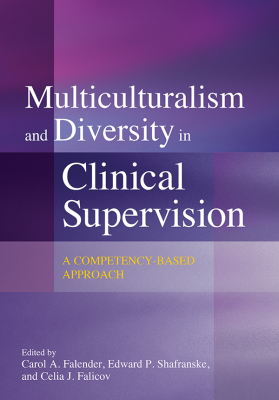 Multiculturalism and Diversity in Clinical Supervision: A Competency-Based Approach, the potential for mixing two very complex domains into one complex book is certainly present.
Multiculturalism and Diversity in Clinical Supervision: A Competency-Based Approach, the potential for mixing two very complex domains into one complex book is certainly present.
Fortunately, there are portions of this book that break down both multiculturalism and supervision into realistic ideas that can be infused into anyone’s personal counseling or supervision style. Whereas some supervision texts are hyperfocused on steps and actions that must be taken to become a competent supervisor, Multiculturalism and Diversity in Clinical Supervision: A Competency-Based Approach takes a step back, instead invoking a more wide-angle view of the supervision process and how multiculturalism is central throughout it. This comprehensive approach is most readily apparent in Chapter 2, where the authors illustrate supervision and culture as interwoven circles in which the client’s, the counselor’s and the supervisor’s personal and cultural values collide within every interaction. Furthermore, the author breaks down each of these levels using vignettes and examples to show the reader how these different areas connect and collide with one another. While this information does not give a map or guideline of how to conduct supervision, it does invoke further contemplation about how one’s own personal tendencies and others’ backgrounds can affect the supervision process, a topic that is often skimmed over in traditional supervision literature.
While the focus of this book is unique and much needed in the supervision literature base, there are some limitations to how the authors structured the text, the most notable of which is that this book is clearly geared toward psychologists and not counselors. For a new or novice supervisor, this omission may prove problematic, as the basic building blocks of supervision for counselors are absent.
The second critique of this book is the creation of its chapters. Instead of following a traditional outline in which each chapter builds toward the next, further elaborating and clarifying ideas from the previous chapter, this text reads more as a series of disconnected articles that have been compiled into one volume. Therefore, each chapter is self-contained, with its own beginning, middle and end, as well as its own particular writing style. The lack of continuity makes this text a somewhat arduous read at times.
But overall, the macro-level focus of Multiculturalism and Diversity in Clinical Supervision: A Competency-Based Approach is a refreshing outlook on how the personal and cultural qualities of counselor and supervisor intertwine within the supervision process. On one hand, the manner in which this book is written may make it a difficult selection for counselors and counselors-in-training who do not yet have a solid foundation in counseling supervision. On the other hand, counselors and supervisors who are up to date on the current counseling supervision literature may find that the ideas within this book can spark self-reflection on how their own personal qualities and cultural orientation arise in the supervision process.
Reviewed by: Mark P. Eades, NCC, University of North Carolina at Greensboro, Greensboro, NC.
Falender, C. A., Shafranske, E. P., & Falicov, C. J. (Eds.). (2014). Multiculturalism and diversity in clinical supervision: A competency-based approach. Washington, DC: American Psychological Association.
